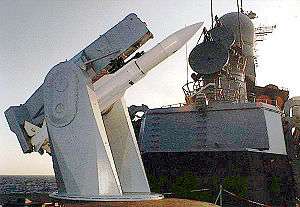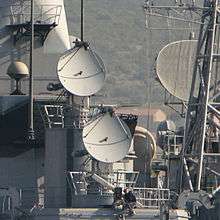Tartar Guided Missile Fire Control System
The Tartar Guided Missile Fire Control System is an air defense system developed by the United States Navy to defend warships from air attack. Since its introduction the system has been improved and sold to several United States allies.


Description
The Tartar Guided Missile Fire Control System, or Mk 74 Guided Missile Fire Control System, or just Tartar, is a US-built medium-range anti-aircraft missile system. The French version used on Cassard class frigates is composed of a vertical rotating magazine holding 40 missiles, a Mk 13 launcher, two AN/SPG-51C fire-control radars and one DRBJ11 three-dimensional air search radar. Though the entire weapon system is commonly called Tartar, tracing back to its original linkage to the RIM-24 Tartar missile, it utilizes medium-ranged RIM-66 Standard missiles.
Deployment
It was installed on numerous US Cruiser and destroyers in the 1960s through early 1990s such as the California class cruisers, Virginia class cruisers, Kidd class destroyers and the Charles F. Adams class destroyer. It is also in use in other countries such as the Fleet escorters of the French Navy Kersaint, Bouvet, Du Chayla and Dupetit-Thouars, and is now in use on the Cassard and Jean Bart.
RIM-66B Standard
Starting in the middle 1960s a new family of guided missiles referred to as the Standard missiles were developed to replace the poor performing missiles used by existing fire control systems. The RIM-66A/B Standard replaced the earlier RIM-24C Tartar used by the system. The new missile made Tartar into a true medium ranged system. Besides having longer range than the RIM-24, the new missile was more accurate and reliable.
New Threat Upgrade
Vessels of the California-class cruisers, Virginia-class cruisers and Kidd-class destroyer had their Tartar systems upgraded to modification 14 or 15 standard which enabled them to employ the Standard Missile 2 as part of the New Threat Upgrade (NTU) program. The New Threat Upgrade equipped vessels could utilize the inertial guidance systems on the SM-2 and time share illumination radars for semi-active homing in the terminal phase of the intercept, increasing the number of targets the Tartar system could attack at the same time. The New Threat Upgrade Tartar ships could function nearly as well as Aegis Combat System equipped vessels, except for dealing with saturation missile attacks. The NTU still requires the AN/SPG-51 radar to acquire a lock on the target and illuminate it just before intercept.
External links
- Global security - MK-74 Guided Missile Fire Control System
- Global security - SM-1 - The SM-1 MR is installed on FFG-, DDG-, CG-, and CGN-class ships equipped with a Tartar combat system.